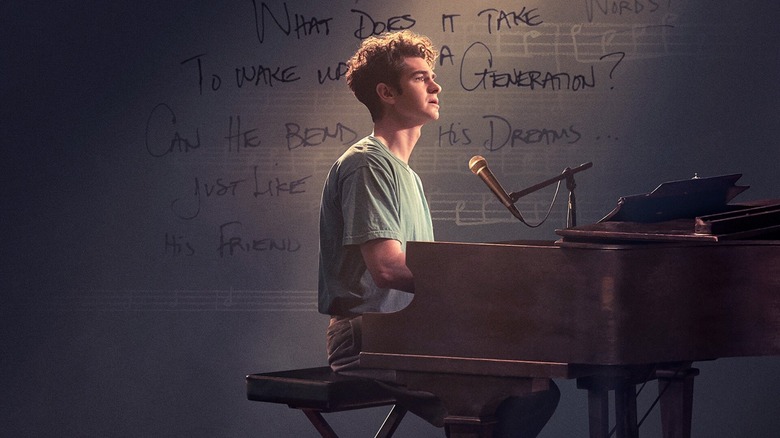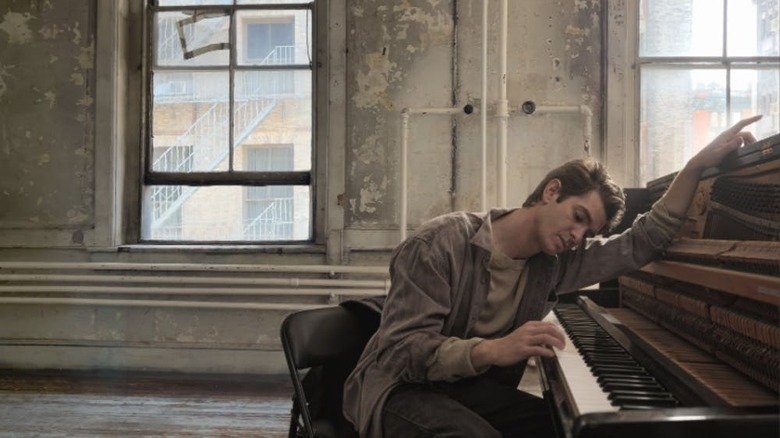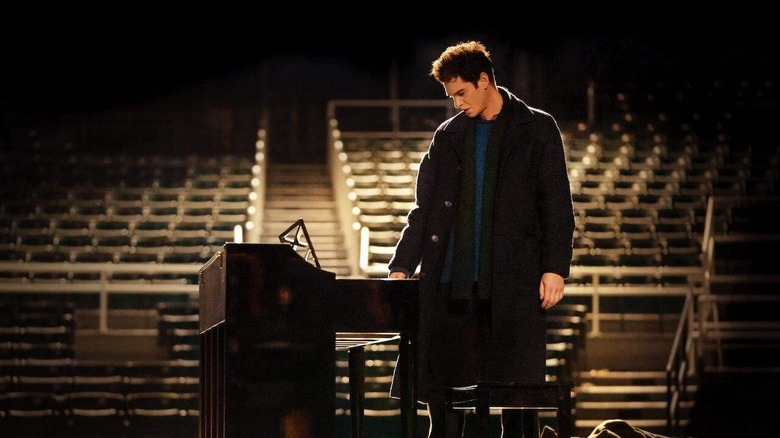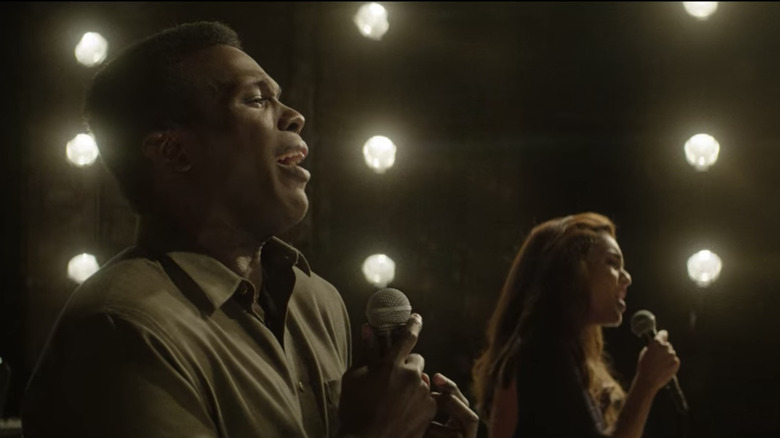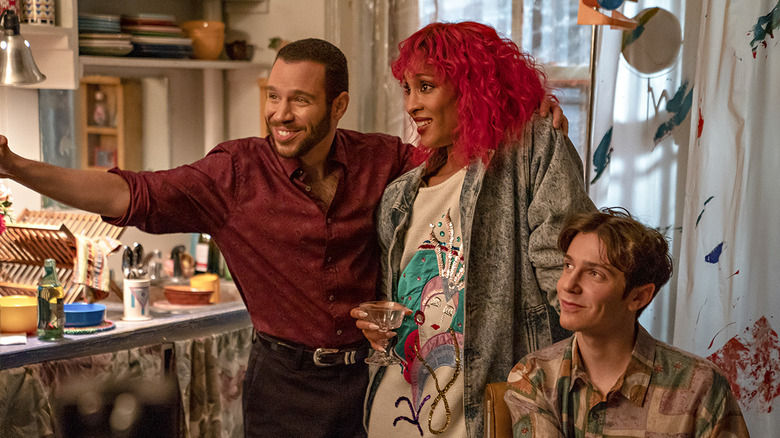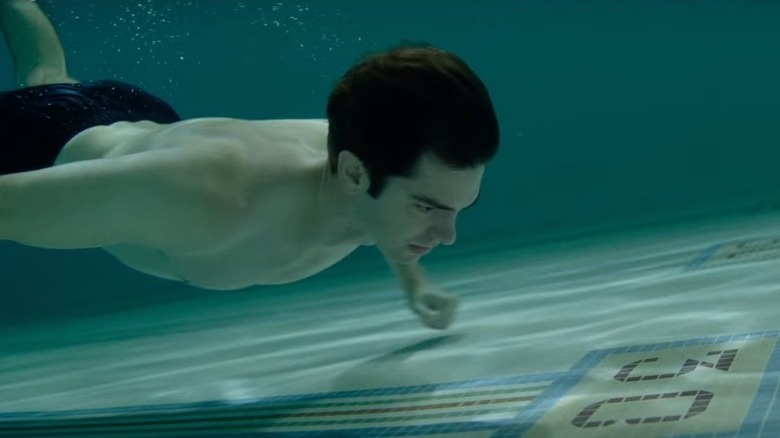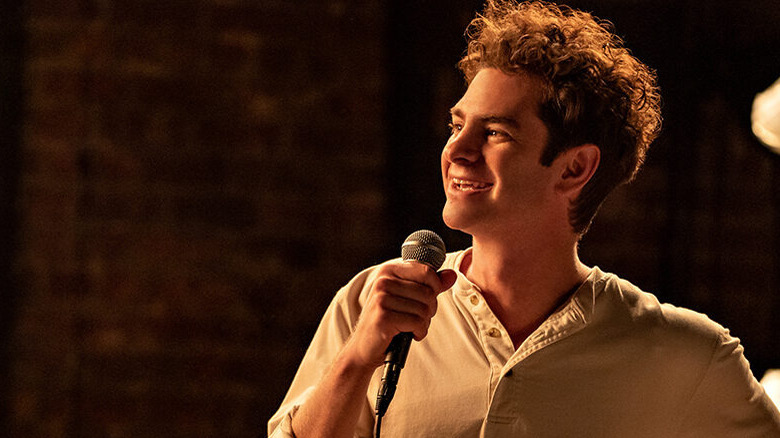Tick, Tick... BOOM! Executive Music Producers On Bringing Broadway To The Big Screen [Interview]
The constant thrum of music guiding "Tick, Tick... BOOM!" should come as no surprise — the recent Netflix film is a musical, after all. But in this case, the endless run of melodies and tunes serves a purpose larger than just genre. This film has a mission that hits close to home for all the theater kids of the world, because the filmmakers set out to construct a cinematic love letter to the works of Jonathan Larson. The theater legend is best known as the creator of "Rent," one of Broadway's longest running musicals, which went on to reshape the theater industry for years to come. And amongst those forever impacted by his compositions are the very creatives behind this film, Lin-Manuel Miranda and two of his most frequent collaborators, Bill Sherman and Alex Lacamoire.
Longtime fans of Miranda and his music won't be surprised to learn of either Sherman or Lacamoire's involvement in his directorial debut — the three are longtime collaborators, and often have a hand in many of the same projects. Sherman and Lacamoire helped bring "In The Hieghts" to the stage, earning both a Grammy and a Tony for their respective work. More recently, they brought the Broadway gem to theaters with the film adaptation. For "Tick, Tick... BOOM!" their friendship with Miranda and their love of Larson worked hand in hand.
"Tick, Tick... BOOM!" is an autobiographical musical originally written by Larson, then reworked years after his death. With Miranda's directorial debut, he brought the story back to the roots of the play Larson created, a rock monologue about a promising young theater composer navigating love, friendship, and the future as a struggling artist in New York City. Paying tribute to Larson meant doing more than adapting his play: the trio wanted to inject as much Larson into the film as possible, both in story and song. As executive music producers, Sherman and Lacamoire were handed the hefty task of adapting the already beloved musical and transforming the music while keeping its spirit intact. In the interview that follows, the duo take us through the process, breaking down the difficulties of bringing a song from stage to screen.
"The path was always clear because the songs are so strong."
I wanted to start by asking you about your own Jonathan Larson origin stories and your connection to his work before the project.
BIll Sherman: I definitely saw the original cast of "Rent." I grew up on Long Island, my parents took me to see "Rent." I was in the last row, literally the last row of the upper deck and I remember just totally being captivated. And then years later, after college, Lin and I shared an apartment and one of the CDs we had in our major CD collection was the off Broadway recording of "Tick, Tick... Boom!" And so Lin started playing it and then we started playing it a lot. And then one summer, or maybe it was a winter, I'm not sure, I got really into the CD and started to learn how to play some of the piano parts and just thought it was such a cool sounding thing. And I loved the songs and I also thought it was this weird parallel of the sad life that Lin and I were half leading when we were making musicals and things when we were kids. What about you, Lac?
Alex Lacamoire: I remember being in Boston, going to college around the time that "Rent" came out and I just remember the craze about this big hot show that was on Broadway. It was a rock musical and I'm a rocker myself so I was very excited to hear that Broadway was rocking. And I remember playing songs from the show, listening to the soundtrack and I just remember the craze about it. I was lucky enough to see the original "Tick, Tick... Boom!" off-Broadway. And I was lucky enough to be a substitute musician on "Rent" on Broadway, because I would play auditions for "Rent." I would play on the show, like be on stage and play keyboard. So Jonathan Larson's music has definitely been around my life and my sphere ever since his music got broadcast to the world.
It certainly feels like every theater kid has a big Jonathan Larson connection and story. So I'm curious, how were you thinking about walking the line between honoring the original music and then transforming it for the film?
Lacamoire: We kind of have this — with Lin, Bill and I — where we've worked with Lin-Manuel long enough to know that when we hear his music, we know what it's supposed to sound like. And I feel like with Jonathan Larson's music, we know what it's supposed to sound like. And that's probably because we grew up with the same kinds of influences that we believe he had. We also knew what "Rent" sounded like and what that world was. So it just became easy to be like, oh, this is how the songs are meant to feel.
Not only because we knew what the palette was, but also I feel like we just knew the origin of where the songs were probably inspired from, his writing style, the direction that he wanted to go in. It just felt very natural to us. So I think what we aim to do as producers or arrangers or orchestrators is just have the songs reach their fullest expression and for us, the path was always clear because the songs are so strong and we think the composition was so strong, but also just our familiarity with his music just helped us know which way to go.
Sherman: I think that's a great answer. I also think when you go to expand things for movies, it's always like you're trying to fill a different space and do a different thing. And so I don't know, I feel like we're always trying to give it more wits, or more ... more gravity. So if it was something that was supposed to be an orchestra, but never got to be, like "Sunday," for example. In off Broadway examples, it's just a piano and bass and drums and stuff like that. And for the movie, we got to use a full orchestra to give it more weight and more gravity.
"The task is the same, but the vocabulary and the colors on the palette are what's different."
Did it change your jobs, transitioning a musical from stage to screen for "Tick, Tick... Boom"? Since, unlike "In the Heights," this is less of a direct translation and pulls songs from other places.
Lacamoire: I'll say this. The task is the same, but the vocabulary and the colors on the palette are what's different, let's put it that way. Because the task is "how do we make this moment really pop on the screen? How do we tell the story through music? How do we elevate the moment so that the music really buoys the story and the emotion and all that?" But with Heights, the vocabulary and the color palettes are salsa horns and Latin percussion instruments and hip hop and all that stuff. But with "Tick, Tick... Boom!" it's rock, it's Billy Joel, it's the Ramones, it's Sondheim and the Scorpions or whatever you want it to be. Yeah, I think it's just a little bit more of a rock based, downtown-y, early '80s or '70s, whatever you want it to be. I think the influences were just markedly different. Is that right, Bill?
Sherman: Yeah. I agree with you. I think that's a wonderful answer.
Are there other touchstone influences that you were thinking about along the way?
Sherman: I think Lin gave us some interesting touchstones. There's one song called "Real Life" where he was like, "I want it to sound big, like Nine Inch Nails-y and little more industrial." And then there's a great shot in "Tick, Tick... Boom!" of Jonathan's tape collection, which gave us a touchstone of things that he might have been into. I think for the score, there's a lot of definitely Elton John and Billy Joel piano rock, and then Talking Heads vibes for some stuff. And then, like you said, Ramones, and then what else? Definitely the theater stuff and definitely all the Sondheim things and "Sunday in the Park" and such. I guess, "Therapy" is the one that doesn't sound like anything else, more of its own mandolin, bluegrass jam. What else? There's Judas Priest in there, there's Peter Gabriel, stuff like that.
Lacamoire: Yeah. I feel like I hear The Who in there as well. There's some Beatles influences as well. Yeah. All across the map.
"I wanted people to hear the song and feel like they wanted to get up off the couch and change the world."
Can you talk me through the process of taking a song from point A, the stage version, to point B, the film version?
Lacamoire: The first thing is, the blueprint is the song. And the songs are so strong. These are songs that work if it's just a voice and a piano and they're that beautiful and that amazing. And then I think we just look at what kinds of sounds and what kinds of sonics, what's the arrangement of the song? How does it feel? And I think a good way to express it is the song "Louder than Words," which is a beautiful song, it's amazing. And I think we just asked ourselves, "Okay, what is this song trying to say, what is a lyric trying to evoke, what is the mood of it?" And I think that one, I know that as we were working on it, there was something about the lyrics that to me felt very much like a call to action. It almost dares people to be better versions of themselves.
I'm a fan of the song, we're big fans of the off Broadway version, but that felt like an opportunity for us to take it a step further and we changed what the drum group was. We added a string section to it. We added more guitars and it felt much more, not trance music, but almost like a trance state. Almost a hypnotic drone that, underneath it all, has a militaristic marching drum vibe that feels like it just allows people to band together and fight for a cause. And I wanted people to hear the song and feel like they wanted to get up off the couch and change the world just by being inspired by what they heard.
So then it becomes our job to make sure that the song, the recorded version of that song, feel that way. So what are the instruments we use or who are the musicians that we call? What do the vocals sound like and what kinds of performance are they giving in the studio? When they sing the frame, does it make you feel the emotions? And if not, then let's do another take until it does. And then beyond that, make sure it's mixed well and get the right mixing engineer on board, listen to it, revise it, change it again, tweak it. And so a lot goes into it on the technical side and the planning side and the emotional side as well.
Sherman: Yeah, I think another great example of that is "Johnny Can't Decide," which was a song that was originally just written for pretty much piano. And we took it and flipped it on its head and put it on guitar. It just felt like a lot of the songs are very piano based, so we went for something that was a little more guitar based, just another example.
"I think that's exciting that he was a step ahead."
That actually reminds me, there's this meta aspect of the movie where John's having this conversation with his producer about how a good song only needs some basic piano and if it can't work on its own, maybe it's not a good song.
Lacamoire: It's really funny. Every time that scene comes on in the movie, I laugh because I know the character Jonathan is talking about and I'll give you a great example. There's a fantastic song in "Rent" called "Out Tonight." And if you play that song on a piano, it sounds crazy. Because it's a guitar riff for one measure followed by one measure of drums. So if you try to play the guitar riff on the piano, it sounds really just not awesome. And then you can't play drums on the piano so you're just kind of sitting there not playing anything. So any person would hear that song on a piano and be like, "What is happening?" But the minute you put in on a guitar and a drum, you know exactly what the song is.
You're like, "Oh yeah, this is straight up '80s. This is some Pat Benatar vibe," whatever you want it to be. It's a different thing. So I know exactly what he talked about because my guess is that he hears something beyond the scope of what the piano could do. And the extension of that is modern music. There are certain tracks that you listen to today that you just can't play on a piano, like certain hip-hop tracks, again, you can't play the drum loop on a piano and have it sound convincing. So there's a lot of things that just rely on what the sonics are and what the instrumentation is. So I think that's exciting that he was a step ahead. He heard something in his head that wasn't quite translatable on 88 keys while that had very much been the way to write a song and a way to convey a song and transmit a song's energy before. So I always laugh when that moment comes on.
When I spoke to Robin a couple weeks ago, he mentioned that "Real Life" began as experimental riffing before finding the emotional journey of the number and I wanted to hear more about that process.
Sherman: I remember Lin had come to us and been like, "Hey, I want it to sound like this Nine Inch Nails thing. I want it to be some more industrial stuff, but—
Lacamoire: I thought he said more like Trent Reznor, Atticus Ross, not so much Nine Inch Nails, right? Or did he actually say Nine Inch Nails?
Sherman: I think he did ... but that's a Lin reference. But he wanted to have this big build and it had to build to this epic thing that was happening as Jonathan was running out and dealing with the fact that his best friend told him that he was HIV positive. And then going, and then sort of leading up into the theater and playing of "Why." And it just had to get bigger and bigger and bigger. And I remember we went through a bunch of different vibes on it, just to try to figure out how to get it to that point, where the peak of it actually was.
And the only lyrics in that whole song are "is this real life." So the whole thing is just an extenuation and a build on that particular theme. So we tried putting the lyric in different places and using different parts of the song to get us there. And then, I don't know, it all naturally just fell into place and anytime Robin sings a note, it's pretty beautiful and wonderful. So it was pretty easy to take his emotional journey and adapt it into a song that worked and had a build and had the right feel for the movie.
"When you watch Jonathan perform it in a cabaret setting, it's powerful, but it's even more powerful in this movie."
Can you also talk about "Swimming?" I imagine that was also a very different process since it's a song that isn't in the show and is brought back to the show.
Lacamoire: Bill and I, we're proud of the movie and we're proud of our work on it, but I know that we often talk to each other like, "Oh yeah, we're proud of this arrangement. We feel really good about it." I think the song itself is kind of peculiar because there's not a really good melody to latch onto for the whole first three quarters of the song and it feels kind of ramble-y lyrically because it's representing the jumbled thought process of a creator who just can't crack a code for something. And musically speaking, I know Bill and I were trying to figure out what that should sound like.
And I think at the end we just came up with a feel that felt like it was really combustible, really explosive, and really frustrated. I think what was fun is to really play the angst. And that's a big thing for the movie, I think. There's a lot of nervous energy to the songs, there's a lot of fear in the songs about running out of time, there's a lot of self consciousness about feeling like you're not good enough. So I think we really wanted to tap into what makes a song feel either aggressive or anxious or uncomfortable or frustrated. So I think we really just got into that in the feel of the drums and the way the guitars played and also in Andrew's performance. I feel like there's a way that Andrew performed that song that it's clear that the brain is channel changing and trying to focus on a particular frequency and it can't quite get there.
And then after all this huge build, the song just releases and opens into this beautiful melody that's supposed to represent the genesis of creation, like when an idea just appears and the muse just gives you everything it needs. And so it opens up with this beautiful melody that it just soars, it just feels beautiful. So I just love that. I think we really find a way to make the music tell the story of the journey, trying to push through a brick wall and banging your head against something trying to create. But then when you've actually hit upon that idea — we found a way to tell that through choir, through this beautiful, angelic choir singing, found a way to do that through this beautiful string section playing, through this beautiful vocal arrangement that our co-producer, Kurt Crowley, created.
All the forces came together to just really find a way to elevate the song. And when you watch that song on YouTube and you watch Jonathan perform it in a cabaret setting, it's powerful, but it's even more powerful, I think, in this movie where you really get the visuals to accompany it and you get the real no-holds-barred treatment for the arrangement.
"After he had taken all these vocal lessons, it was really unbelievable just the amount of change... By the end of it, he's this unbelievable singer."
So, you were working with singers from a variety of backgrounds and... Alexandra Shipp has talked a little about not being a traditional musical theater voice and then there's Andrew who hasn't really sung before this project. But obviously they're all incredible singers, so I'm curious about how those different experience levels affect your end of the job.
Sherman: I think it's kind of the fun of making a musical film. You don't always get people who are necessarily theater singers or necessarily pop singers. They all come from different backgrounds and have different strains and different things. Yeah, and the interesting thing about filmmaking as opposed to theatering — theatering, that's a new word I made up — as opposed to working in theater, is you get to work in a studio and you get to be very micro about things. So we were in the studio with Andrew and we put him with a bunch of vocal teachers and he really embraced this wanting to sing and wanting to make this as magical thing as possible. And then we were in the studio with him, just watching him after he had taken all these vocal lessons and it was really unbelievable just the amount of change, the amount of development he got in his voice and by the end of it, he's this unbelievable singer.
And then there's more polished people like Vanessa Hudgens, but then you're still in the studio with her and you still get to take apart the things and figure out what she really wants to do and how her singing will affect the character. Same thing with Josh Henry who's a professional music theater guy. And so shaping the stuff with him, it's a different, but just as rewarding experience to really put the stuff under the microscope and figure out how to get the emotions that they're trying to get through, get past, get over as actors, but also make it sound as good as possible.
And of course I have to ask about the '90s music segue of "Play Game."
Lacamoire: I love that sequence. That video is so good. That is so on point, everything about it. It really took me back to my Yo! MTV Raps days. That's exactly what it would look like, it was perfect. No, that was just awesome. That was just Lin's brilliant idea. He's like, "Yeah, we've got to get Black Thought on this." And we're like, "Yep, that sounds great." And who did the track for that, Bill?
Sherman: It's a guy named Kwame. I don't know his full name. Kwame is one of Atlantic Records' people and it was executive produced by our friend Riggs Morales at Atlantic Records who's been in A&R there for a hundred years. Yeah, and then Tariq came in and dropped the verse and crushed it. It was a great, Pacific grade, funny respite in the movie. I loved it.
Lacamoire: Yeah. And they were able to use Jonathan's voice to actually be a part of it. If you listen to it, you hear the phrase "P-P-P-Play Game", it's actually Jonathan Larson's actual voice sample part of the piece. So it's part of the fabric. So I think they just did it in such a smart way, even the sounds that were used was just old school sound. It was just perfect. Yeah, a very fun moment.
Along those lines, are there other musical easter eggs hidden in the movie that you can point out?
Lacamoire: The score itself is a bunch of Easter eggs, in terms of, these are all songs that are from Jonathan Larson's catalog, many of which might not have been heard by more than probably 20, 25 people. But it was Lin's idea to make all of the underscore for the movie be based on the songs that Jonathan wrote, whether they were songs from "Tick, Tick... Boom!" or they're songs from Jonathan's trunk. So it was really fun. The songs that I know I hadn't even heard of before this movie, but when he's in the focus group there's a song that's called Ever After that's playing underneath. When Jonathan and his girlfriend, Susan, are on the rooftop, you hear in the background this freestyle song that he wrote. And even the end credits has a song that was written by him that I know that I hadn't heard before. So really just Jonathan is all over the movie and as well he should be.
Sherman: The two other funny ones are the "Green, Green Dress," which comes from the radio, which is in fact, Josh Henry singing, "Green, Green Dress," an R&B version of it. And then another one I like is, when they're in the car driving toward the Victory Towers, there's a CNN jingle or what is supposed to be a CNN jingle, which is in fact something that Jonathan wrote that we just developed for the radio. But yeah, there's little things like that.
"Tick, Tick... BOOM!" is now streaming on Netflix.
